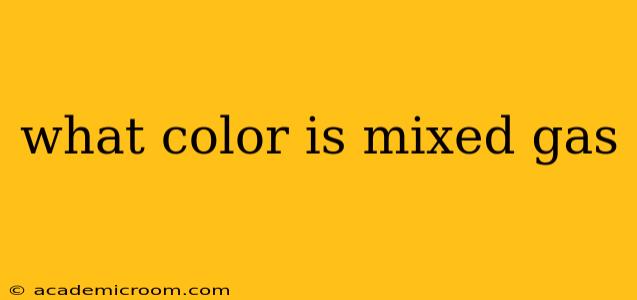What Color is Mixed Gas? The Surprisingly Complex Answer
The color of "mixed gas" isn't a simple answer; it depends entirely on the composition of the mixture. There's no single, universally accepted color for mixed gases. The appearance can range from completely colorless and transparent to various shades depending on the gases involved and their concentrations. Let's explore some scenarios:
What gases are commonly mixed?
Mixed gases are used in a wide variety of applications, from industrial processes to medical treatments. Common components found in mixed gas cylinders include:
- Oxygen (O2): Colorless and odorless.
- Nitrogen (N2): Colorless and odorless.
- Carbon Dioxide (CO2): Colorless and odorless (in its gaseous state).
- Helium (He): Colorless and odorless.
- Argon (Ar): Colorless and odorless.
- Hydrogen (H2): Colorless and odorless.
- Acetylene (C2H2): Colorless, but can have a slight ethereal odor.
Because many common gases are colorless and odorless, the mixture will likely also appear colorless and odorless. However, certain exceptions exist. The presence of even a small amount of a colored gas can alter the overall appearance.
What if the mixed gas contains a colored component?
Some gases, or their components, possess distinct colors. For example:
- Chlorine (Cl2): A yellowish-green gas. Even a small amount of chlorine in a mixture would likely give it a pale yellowish tint.
- Nitrogen Dioxide (NO2): A reddish-brown gas. Similar to chlorine, a small concentration would make the mixture appear slightly brownish.
- Certain refrigerants: Some refrigerants can have a slight color depending on their composition.
In these cases, the color of the mixed gas would be influenced by the colored component's concentration. A high concentration of a colored gas would result in a more intensely colored mixture, while a small concentration might lead to a subtle color change, perhaps only noticeable in a large volume.
How is the color of mixed gas determined?
The color of a mixed gas isn't typically something visually identified. Instead, the composition is determined through analytical techniques, not visual inspection. These techniques include:
- Gas chromatography: Separates and identifies the components of a gas mixture.
- Mass spectrometry: Measures the mass-to-charge ratio of ions, providing information about the molecular weight of each component.
- Spectroscopy: Analyzes the interaction of electromagnetic radiation with the gas mixture to identify its constituents.
These methods provide accurate and reliable information about the gas mixture's composition, irrespective of its appearance.
Can you visually determine the contents of a mixed gas cylinder?
No. Never attempt to identify the contents of a gas cylinder by its appearance. Rely on the cylinder's labeling and accompanying documentation. Mixed gas cylinders should always be clearly labeled with the precise composition and concentrations of each gas. Mishandling compressed gases can be extremely dangerous, and relying on visual identification is unsafe and unreliable.
In conclusion, the color of mixed gas is highly variable and dependent on the specific gases included and their concentrations. The safest and most reliable way to determine the contents of a mixed gas cylinder is to consult the cylinder's label and safety data sheet (SDS). Visual inspection alone is insufficient and potentially hazardous.
